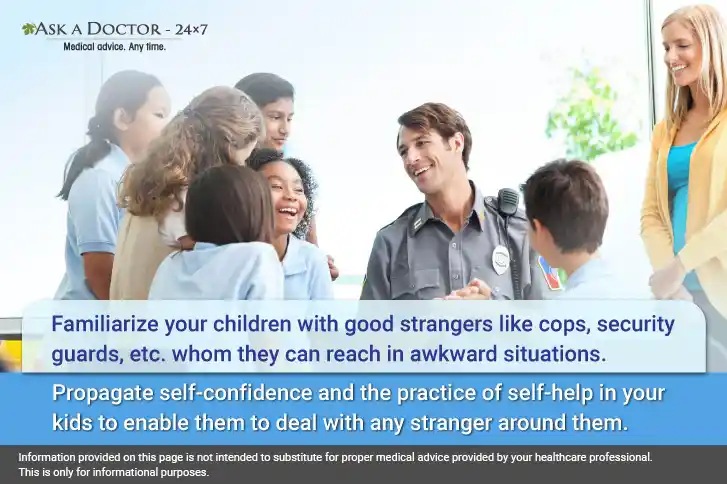7 Tips To Teach Your Toddlers About 'Stranger Danger'(Without Horrifying Them)
Are you a parent who wants your child to stay alert from strangers without creating a buzz around it? If you worry that teaching about stranger danger may give rise to anxiety and distress in your children, then reading through this blog may help. We as adults know that a stranger is an unknown or unidentified person, but describing a strangerŌĆÖs image to your toddlers could be tricky. Kids may not understand how a stranger looks different from others or how to recognize his suspicious intentions. As a parent, it becomes your responsibility to teach this to your children but simply and modestly.
LetŌĆÖs learn 7 simple ways; how to educate your children about ŌĆśstranger dangerŌĆÖ without horrifying them.
7 Ways to Educate Your Children About ŌĆśStranger DangerŌĆÖ
Follow the below postulated seven steps for your children:
1. Teach Them to Identify Unsafe Situations
Before introducing your toddlers to the ŌĆśstranger dangerŌĆÖ concept, inform them what strange situations they may get into. Create such real-world scenes while playing with your kids and ask how they will deal with such awkward situations like if they get separated from their family, get lost in a public place, or stay alone in an elevator, school bus, or washroom. Remember your aim is not to scare your child but just to acquaint him with the solutions to come out of the dangerous situations, so be as creative as you can while conveying your ideas.
2. Teach Them About Good Strangers

As a part of the school curriculum toddlers are often taught about community helpers like policemen, doctors, firefighters, security personnel, and others. Talk more about the good things these people do for our society by telling stories or reciting poems about them. Educate your toddlers about the uniforms, and accessories used by these community servants. Show them real videos of policemen, doctors, or others helping or interacting with young kids. This helps children to know that not every other person is evil and they can reach good strangers in need.
3. Teach Them Politely, Things Beyond Their Capabilities
A stranger with the wrong intention may approach a young kid for some kind of help. Teach your kid that a grown-up should ask another adult and not a small kid for help, also there is nothing wrong in saying ŌĆśNoŌĆÖ to a stranger asking for some favor. Engage kids in role plays where they may help other kids but not unknown adults for unusual requests. Remember, our intention is not to encourage unkindness but to promote alertness in kids to prevent them from falling prey to spurious intentions.
4. Teach Them Cartoon Characters are Fun, Not Real
All kids are fond of cartoon characters and mostly each child has a favorite one. Unfortunately, children especially toddlers believe in cartoons vigorously. Research studies propose that this conviction in kids has a significant impact on their behavior or attitude and could lead to some adverse consequences. For young kids, as real as the cartoon hero's character so is the villainŌĆÖs. Introducing them to bad strangers may drive kids to create self-imaginary images of strangers as cartoon villains which may sound interesting but is dangerous. A toddler must know a stranger may look like other people around. Take your toddlers regularly to the parks or zoos, and introduce them to animals, birds, and other living creatures to make them learn the differences between the real and virtual worlds. Emphasize on nonexistence of cartoon characters to prompt realization about the real world and real people.
5. Tell, Read, and Show Stranger Danger Stories
The easiest way to educate your toddlers about safety rules for strangers is to do it in the form of stories. You may pretend to play a stranger's role to make it convincing. Portray a stranger as a person who could have harmed the kid in the story but the foresight shown by the child saved him. Appreciate the intelligence and alertness shown by the kid which would inspire your toddler to follow the safety rules against strangers.
6. Teach Them to Use Codes to Speak for Them in Danger
You can create some personal codes to communicate with your kids during an emergency. Practice the use of these secret codes regularly. Keep these signs or codes simple so that your toddler can remember, recall, and use them quickly in any odd situation. Use of hands, fingers, or eyes to notify any danger could be helpful.
7. Ensure Not To Put Them in a State Of Dilemma
We often instruct our kids not to eat from or talk to strangers. But at times we confuse them by forcing them to accept offerings from people known to us but not to them. Tell your toddlers that itŌĆÖs okay to eat from others but only in the presence of parents or family members. Yet, if our toddlers do not respond to people whom they donŌĆÖt know or are not familiar with, we should not get embarrassed but rather be happy that our childrenŌĆÖs instincts are stopping them from doing so. Certainly, it is not about how we or other people feel about it, itŌĆÖs about whether our child is feeling safe and secure.
Conclusion
Parenting is never easy but with the evolving landscape of nuclear families, it has become critical to ensure the safety of our children at home, school, or any other public place. Busy lifestyles may restrain us from staying around our toddlers every moment, thus kids must be enlightened about the fundamentals of personal safety including the concept of ŌĆśstranger dangerŌĆÖ. As a parent, ensure not to frighten your kids or lower their self-confidence but just to inculcate basic observance and diligence in them. Children are intricate, not only strangers but strange behavior by any known person can upset them or may have an intense impact on their cognitive development.
If you observe unexplained behavior in your kids and are clueless about how to deal with it, then Ask a Psychologist online or simply text your queries at Ask a Doctor 24x7 to get the right help.
Recently Answered Queries Related to Children's Anxiety and Stress
- Suggest Treatment For Anxiety
- Suggest a Remedy To Prevent the Child From Being Hyper And Abusive
- Suggest Treatment For Symptoms Of Depression
- Diagnosed With Anxiety Disorders. What Is The Cause?
- Is There Anything I Can Do To Overcome Social Phobia?
- Is Anxiety Hereditary?
- What Causes Pricking Sensation On Hands, Legs, Feet And Neck?
- Suggest Medicine For Anxiety
Disclaimer: Information provided on this page is not intended to substitute for proper medical advice provided by your healthcare professional. This is only for informational purposes.
Ask a Specialist
Recent Questions


